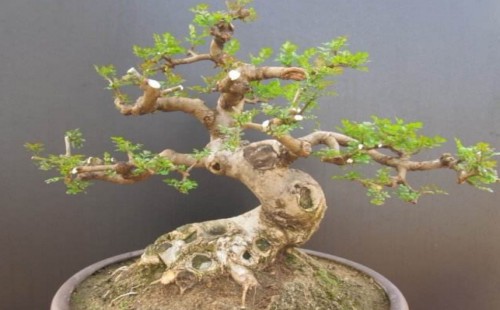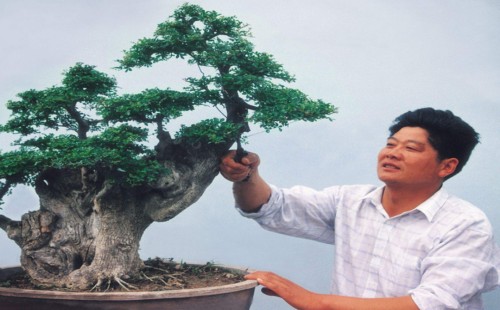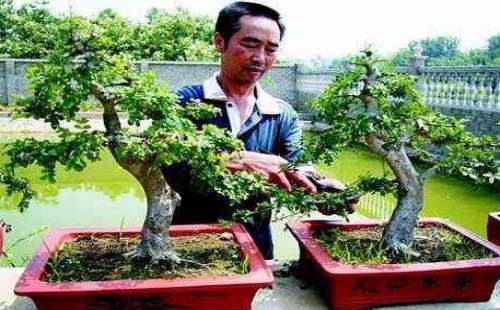How to prune the white wax bonsai
Beautiful bonsai works must have unique modeling, and modeling is often inseparable from pruning, and pruning means play a very important role in the process of bonsai modeling. Because the branches are cut well or not, it will directly affect the beauty and ornamental effect of bonsai. The same is true for the white wax bonsai, it can be said that pruning is the most commonly used and important way in the modeling means of the white wax bonsai. So, how to prune the white wax bonsai?

Although butted white wax is a kind of deciduous tree, it has strong adaptability to the environment, rapid growth, strong plasticity and resistance to pruning, but pruning can not be carried out blindly, because the pair of white wax bonsai which can not be pruned well is not a bonsai work at all. It can be seen that its modeling effect is still ornamental value, either greatly discounted or lost, so we should take seriously the pruning work for the white wax bonsai.
I. balanced pruning
Balanced pruning is the omni-directional pruning of the whole bonsai, and this pruning technique is usually pruning before the white wax bonsai trees are basically formed or are about to be used in the exhibition. Through the comprehensive pruning of the whole bonsai and repeatedly considering the retention and choice of the branches, the branches of the bonsai tree can become more plump, the shape is more mature, the plant shape is more beautiful, and the ornamental value is higher.
2. Unbalanced pruning
Unbalanced pruning is actually a way to adjust the local branches of bonsai trees, that is, non-comprehensive pruning. It is mainly based on the details of the physiological characteristics, branch growth and modeling effect of white wax to avoid the emergence of morbid and incomplete branches, including cutting and branch control.
1. Draw scissors
The extraction and cutting work is usually carried out when the white wax pile scene survives and stays, mainly to cut off all the redundant branches, which can not only improve the bonsai permeability and light area, but also make the nutrients more concentrated transportation. let the remaining branches grow more robust, so as to shorten the storage time of branches.
2. Branch control
In the initial stage of branch storage and modeling, due to the influence of lighting, top dominance and many other factors, the whole branches of the original bonsai tree are often out of sync, and the growth rate between branches is also different. In order to promote the growth of weak branches as soon as possible, we should tail up most of the branches whose proportion is in place in order to achieve the purpose of controlling only. The purpose of this is to achieve a coordinated effect on all branches as a whole, by balancing the growth of branches, so that a small number of branches grow immature and develop rapidly, so as to avoid affecting the appearance.
Third, pruning with leaves
Foliage pruning, mainly refers to the short pruning nodes must take leaves, especially when preparing to leave a bud, to bring leaves. But if there are no leaves on the branch, the branch should be cut down to the leafy place to achieve the effect of forcing the bud. Wait until the remaining part of the bud sprouts normally, and then re-prune it in place. This is mainly caused by the physiological characteristics of white wax and the dredging effect of tree sap. Therefore, for docking white wax bonsai pruning, it is generally necessary to carry out leaves, otherwise, it may lead to shearing, or even cause branches to die.
Fourth, reserve pruning
As the wound healing ability of different tree species is different, we also need to be prepared in the process of pruning, usually with prevention as the main reserve. If it can not be done at one time, it can be done several times, leaving 1-2 more spare bud points each time. Wait until the remaining bud point to pull out the twig to become strong, or when the reserved site naturally wilts, then cut it off. But in this case of pruning behavior, will inevitably encounter thick branches, cut off will leave a larger wound, prone to atrophy, so some can be reserved appropriately. In contrast, the wound left by twigs tends to atrophy is not very obvious, or much smaller, we just need to keep it shorter.
Time: 2019-06-06 Click:
- Prev

How to trim the white wax bonsai in order to keep the appearance beautiful
Docking white wax bonsai is a work that has been deliberately processed by people. although it has been trimmed for a long time to maintain a perfect modeling effect, it still has not lost its vitality and can often continue to grow. On the contrary, if it is not pruned in time, with the continuous germination and growth of new branches
- Next

Treatment of Branches in the Modeling of Fraxinus chinensis Bonsai
Pruning is one of the most commonly used means of tree bonsai modeling, and how to prune branches to be more aesthetic has always been worthy of bonsai creators to explore. However, for different creators, their creative personality, thinking, temperament, self-cultivation, preferences and so on are often different.
Related
- Fuxing push coffee new agricultural production and marketing class: lack of small-scale processing plants
- Jujube rice field leisure farm deep ploughing Yilan for five years to create a space for organic food and play
- Nongyu Farm-A trial of organic papaya for brave women with advanced technology
- Four points for attention in the prevention and control of diseases and insect pests of edible fungi
- How to add nutrient solution to Edible Fungi
- Is there any good way to control edible fungus mites?
- Open Inoculation Technology of Edible Fungi
- Is there any clever way to use fertilizer for edible fungus in winter?
- What agents are used to kill the pathogens of edible fungi in the mushroom shed?
- Rapid drying of Edible Fungi

